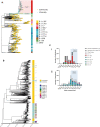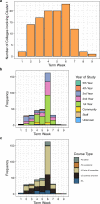Genomic epidemiology of SARS-CoV-2 in a UK university identifies dynamics of transmission
- PMID: 35136068
- PMCID: PMC8826310
- DOI: 10.1038/s41467-021-27942-w
Genomic epidemiology of SARS-CoV-2 in a UK university identifies dynamics of transmission
Abstract
Understanding SARS-CoV-2 transmission in higher education settings is important to limit spread between students, and into at-risk populations. In this study, we sequenced 482 SARS-CoV-2 isolates from the University of Cambridge from 5 October to 6 December 2020. We perform a detailed phylogenetic comparison with 972 isolates from the surrounding community, complemented with epidemiological and contact tracing data, to determine transmission dynamics. We observe limited viral introductions into the university; the majority of student cases were linked to a single genetic cluster, likely following social gatherings at a venue outside the university. We identify considerable onward transmission associated with student accommodation and courses; this was effectively contained using local infection control measures and following a national lockdown. Transmission clusters were largely segregated within the university or the community. Our study highlights key determinants of SARS-CoV-2 transmission and effective interventions in a higher education setting that will inform public health policy during pandemics.
© 2022. The Author(s).
Conflict of interest statement
R.H. is an employee of AstraZeneca AB. The remaining authors declare no competing interests.
Figures





References
-
- Group, C.s.T.F. Risks associated with the reopening of education settings in September. 2021 (2020).
Publication types
MeSH terms
Substances
Grants and funding
LinkOut - more resources
Full Text Sources
Medical
Miscellaneous

